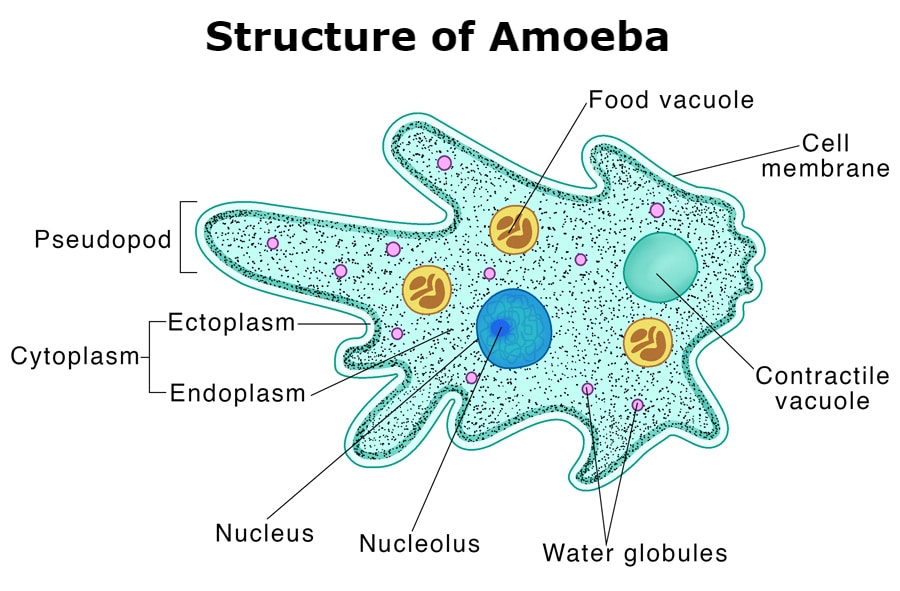In the hidden realms of microscopic life, the amoeba stands as a captivating example of simplicity and adaptability. As a single-celled organism, amoebas belong to the phylum Sarcodina and showcase a unique way of life. In this detailed article, we will delve into the fascinating world of amoebas, exploring their structure, behaviors, life cycle, and ecological significance.
1. Anatomy and Structure
Amoebas are characterized by their simple yet versatile structure. Typically ranging from 20 to 100 micrometers in size, these unicellular organisms lack a fixed shape. Their fluidic bodies consist of a semi-permeable cell membrane, endoplasm, and ectoplasm. Amoebas move and engulf their food using pseudopods, temporary extensions of the cell membrane.
Structure of an amoeba
The structure of an amoeba is relatively simple, yet it is highly adaptable and allows for the organism’s unique mode of life. As a single-celled organism, the amoeba lacks complex tissues and organs. Here is an overview of the structure of an amoeba:
- Cell Membrane:
- The outer boundary of the amoeba is defined by a flexible and elastic cell membrane.
- This membrane is semi-permeable, allowing the movement of water, gases, and small molecules.
- Cytoplasm:
- The interior of the amoeba is filled with a gel-like substance called cytoplasm.
- The cytoplasm contains various organelles, nutrients, and structures necessary for the cell’s metabolic activities.
- Nucleus:
- The nucleus is a prominent organelle within the amoeba, housing genetic material in the form of DNA.
- It controls the cell’s activities, including growth, reproduction, and response to environmental stimuli.
- Pseudopods:
- Amoebas are known for their distinctive locomotion using pseudopods (or “false feet”).
- Pseudopods are temporary extensions of the cell membrane that enable the amoeba to move, engulf food, and interact with its environment.
- Food Vacuoles:
- Amoebas are heterotrophic, meaning they obtain nutrients by ingesting other organisms.
- When an amoeba captures food particles, it forms a food vacuole where digestion takes place.
- Contractile Vacuole:
- To regulate water balance within the cell, amoebas often possess a contractile vacuole.
- The contractile vacuole helps expel excess water, preventing the cell from bursting due to osmotic pressure.
- Cyst Stage:
- In response to unfavorable conditions, amoebas can enter a dormant cyst stage.
- The cyst is a protective structure that encapsulates the amoeba, allowing it to withstand harsh environmental conditions.
- Endoplasm and Ectoplasm:
- The cytoplasm of an amoeba is often divided into an inner, more fluid-like region called endoplasm and an outer, gel-like region called ectoplasm.
- This differentiation aids in the formation of pseudopods and the overall movement of the cell.
The structure of an amoeba is dynamic, and its adaptability is particularly evident in the way it changes shape and extends pseudopods for movement and feeding. This simple yet effective cellular architecture allows amoebas to thrive in a variety of environments, from freshwater habitats to soils and organic matter.
2. Behavior and Locomotion
A defining feature of amoebas is their amorphous movement, propelled by the extension and contraction of pseudopods. This unique locomotion allows them to navigate diverse environments, from freshwater habitats to soil and decaying organic matter. Amoebas exhibit remarkable responsiveness to environmental stimuli, enabling them to detect and move toward sources of food.
3. Feeding Mechanism
Amoebas are primarily heterotrophic, feeding on bacteria, algae, and organic debris. Their feeding process involves the formation of pseudopods around the prey, enclosing it in a vacuole. Digestive enzymes are then secreted into the vacuole, breaking down the engulfed particles into simpler substances that can be absorbed by the amoeba.
4. Reproduction
Amoebas reproduce through a process called binary fission, wherein a single cell divides into two identical daughter cells. Prior to division, the nucleus undergoes mitosis, ensuring each daughter cell receives a complete set of genetic material. This rapid and efficient mode of reproduction allows amoebas to proliferate in favorable conditions.
5. Life Cycle
The life cycle of amoebas typically involves a balance between feeding, growth, and reproduction. As environmental conditions fluctuate, amoebas can enter a dormant cyst stage, encapsulating themselves in a protective covering. This cyst stage allows them to withstand adverse conditions and facilitates dispersal to new environments.
6. Ecological Significance
Amoebas play a vital role in ecosystems as decomposers, contributing to the breakdown of organic matter. Their ability to regulate bacterial populations in aquatic environments is essential for maintaining ecological balance. Additionally, amoebas serve as model organisms in scientific research, providing insights into cell biology and the study of microbial life.
7. Human Interaction
While most amoebas are harmless to humans, some species can cause diseases. Notably, the genus Entamoeba includes species that can infect the human digestive system, leading to conditions such as amoebic dysentery. Understanding the diversity of amoebas and their ecological roles is crucial for managing potential health risks.
Conclusion
Amoebas, despite their microscopic size, embody the resilience and adaptability of life in its simplest form. From their fluidic movements to their role as ecological decomposers, amoebas offer a glimpse into the dynamic world of single-celled organisms. As research continues to unravel the mysteries of these microscopic marvels, amoebas remain a testament to the astonishing diversity and complexity inherent in the smallest corners of the natural world.

